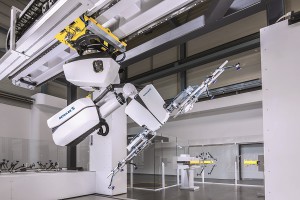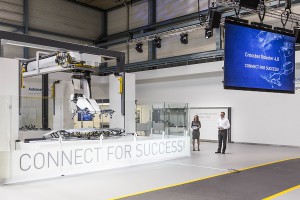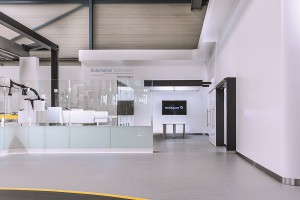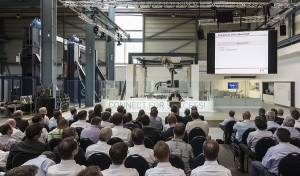 Schuler unveils the fourth generation of Crossbar Robot, called Crossbar Robot 4.0. These robots are used to transfer parts from one stage of a press line to the next: they can remove up to four parts at a time from the die, change their orientation where necessary, and place them directly into the next die.
Schuler unveils the fourth generation of Crossbar Robot, called Crossbar Robot 4.0. These robots are used to transfer parts from one stage of a press line to the next: they can remove up to four parts at a time from the die, change their orientation where necessary, and place them directly into the next die.
 Besides its revolutionary and functional design, the most striking development is probably the robot’s improved performance: “The Crossbar Robot 4.0 can convey up to 15 parts per minute and is thus faster than ever,” stresses Schuler Managing Director Lothar Fischer. “Together with the Crossbar Feeder for the automation of servo press lines, we are setting new standards in terms of speed.” The easy-to-program Crossbar Robot is ideal for automating conventional mechanical and hydraulic press lines – also for loading and unloading – as well as for retrofitting existing lines.
Besides its revolutionary and functional design, the most striking development is probably the robot’s improved performance: “The Crossbar Robot 4.0 can convey up to 15 parts per minute and is thus faster than ever,” stresses Schuler Managing Director Lothar Fischer. “Together with the Crossbar Feeder for the automation of servo press lines, we are setting new standards in terms of speed.” The easy-to-program Crossbar Robot is ideal for automating conventional mechanical and hydraulic press lines – also for loading and unloading – as well as for retrofitting existing lines.
A modified drive system with two motors and new transmission has significantly boosted the Crossbar Robot’s speed – and halved its weight: making the “artificial arm” some 20 percent more dynamic. The maximum load (including tooling), however, has remained unchanged at 90 kilograms. Thanks to an innovative energy management system with integrated energy recovery, the robot’s energy efficiency has also improved by 20 percent.
Schuler unveiled the Crossbar Robot 4.0 at its new “Automation TechCenter” in Gemmingen, where customers were able to get a first impression of the company’s latest innovation. Open throughout the year, the new test facility enables the simulation of processes based on customer specifications – from the distance between presses, to die layout, to slide movement.
As the Crossbar Robot is mounted overhead on a track suspended from the ceiling, it can cover distances between presses of up to ten meters. Such large gaps are typical for older lines which need space for an intermediate station – something not required by the Crossbar Robot as it can change the part’s orientation either in the air or in the die. “This not only replaces two former devices and increases the space for maintenance in the press gap, but also significantly increases the line’s output performance,” summarizes Lothar Fischer.
 The Crossbar Robot is based on a six-axis industrial robot, to which Schuler’s engineers have added a further two axes. These represent the hand of the robot arm and the horizontal drive, thus greatly increasing maneuverability, flexibility and output. And thanks to its process data interface, the new Crossbar Robot is already well prepared for the Industry 4.0 era. Its intelligent networking capabilities turn it into an analysis tool which can monitor processes and report any errors which may occur. The Crossbar Robot 4.0 therefore plays a decisive role in securing high and consistent productivity – forming an ideal bridge into the future for press lines.
The Crossbar Robot is based on a six-axis industrial robot, to which Schuler’s engineers have added a further two axes. These represent the hand of the robot arm and the horizontal drive, thus greatly increasing maneuverability, flexibility and output. And thanks to its process data interface, the new Crossbar Robot is already well prepared for the Industry 4.0 era. Its intelligent networking capabilities turn it into an analysis tool which can monitor processes and report any errors which may occur. The Crossbar Robot 4.0 therefore plays a decisive role in securing high and consistent productivity – forming an ideal bridge into the future for press lines.



